Blogging Marvel’s Master of Kung Fu, Part Eight
Deadly Hands of Kung Fu #9 featured a Doug Moench-Mike Vosburg story whose sole purpose was to reinforce (in the fashion of the hit television series, Kung Fu) that martial arts is about discipline and control and not violence. Of course, making this point provides ample opportunity to portray martial arts violence since conflict is inevitable within the confines of action-adventure storytelling.
The story gets underway when Shang-Chi stops a mugger in the park and finds himself challenged by Johnny Chen, the local martial arts champion whose arrogance and insecurities demand he publicly demonstrate his superiority to Shang-Chi. The fact that Mike Vosburg draws Chen to strongly resemble Bruce Lee (who could exhibit an arrogant side both and on and off screen) only adds another level to the story.
The real key here is the young Asian-American boy who also witnessed Shang-Chi’s heroism and whose hero worship of him leads to unhealthy projection and deception. The dangers of idolizing those we admire is the second plot strand that points back to Bruce Lee in this story. Given that this was another of Doug Moench’s scripts concerned with the non-violent philosophy of martial arts being ignored amidst the martial arts craze sweeping the West, his decision to paint the most recognizable face of martial arts as flawed and highlight the shortcomings of fandom was particularly daring.
Deadly Hands of Kung Fu #11 saw the series return after a one-issue hiatus for a political story from Doug Moench and Mike Vosburg, but one again focused on the ineffectiveness of non-violence in a violent society lacking in self-control and moderation. This late-period campus unrest storyline would prove to be Mike Vosburg’s last for the series. Moench’s script looks at the deadly combination of political extremes and connects it via flashback (in the style of the Kung Fu television series) to a lesson Shang-Chi learned while studying at his father’s Honan retreat. Despite Shang-Chi’s well-reasoned plea to avoid violence, a peaceful demonstration turns into a near-riot on campus and results in tragic death. The importance isn’t so much that Moench was treading the same ground Stan Lee had walked in the pages of The Amazing Spider-man long before the Kent State tragedy made national headlines, but that Moench again signals that Shang-Chi’s time with Sir Denis Nayland Smith (and even his time opposing his father) will be limited by the fact that a man of peace who resorts to violence will never find the harmony he seeks.
The series’ new artist Rudy Nebres debuted with Issue #12 to illustrate Doug Moench’s six-part epic concerning The Golden Dragon. The storyline would run through Issue #18 (Issue #15 was an all reprints issue). This was the Shang-Chi storyline that fans had been waiting for since the companion magazine’s launch for it was finally one with the same scope and drama found in the color monthly parent title, Master of Kung Fu.
Inspired by Dashiell Hammett’s The Maltese Falcon, the Golden Dragon saga starts off with Shang-Chi attending a Chinatown performance by the magician Cho-Lee (based on the Bamberg magical dynasty – specifically David Bamberg, the last of the dynasty, who performed under the stage name of Fu Manchu). Mid-way through the show, the performance is interrupted when thugs attempt to abduct Cho-Lee’s assistant Shareen after the magician has made her disappear through a trapdoor to the basement. Shang-Chi rescues Shareen from a dangerous hostage situation and averts tragedy. As good an artist as Rudy Nebres is, his work is so close to Gene Colan that one cannot help think of how much Cho-Lee in his magician’s robes resembles Colan’s vampire lord from Marvel’s Tomb of Dracula series or even Colan’s take on Dr. Strange.
Shang-Chi is told that Shareen is Cho-Lee’s sister. The thugs reveal they were hired by someone called Shadow-Thief to use the girl to bargain for a priceless statuette of a Golden Dragon. Cho-Lee’s assistant Kwai calls the police while Shang-Chi agrees to accompany Shareen to the Port Authority Transportation terminal to retrieve the statuette from the locker where she has hidden it. En route to the bus terminal, more thugs make an attempt on their lives, but they escape and narrowly avoid the violent car crash that claims their pursuers’ lives.
At the Port Authority terminal, Shareen retrieves the Golden Dragon from the locker only to be confronted by a sword-wielding ninja claiming to be Shadow-Thief. Shang-Chi battles the ninja, but the statuette shatters when it falls to the ground revealing it to be a worthless imitation. Shadow-Thief is revealed as Cho-Lee who flees the scene, leaving Shang-Chi to rescue Shareen who Cho-Lee pushed over the railing and left her clinging to the outside of the stairwell by one hand.
Shareen reveals she and Cho-Lee are not siblings, but estranged lovers. She claims to be an agent of the Chinese government determined to return the Golden Dragon to the People’s Republic of China where it was stolen from a museum. She claims Cho-Lee believes the artifact possesses mystical powers and covets it for himself. Shang-Chi resolves to help her return the real Golden Dragon to China when they are confronted by still more thugs led by Kwai, Cho-Lee’s assistant as the first chapter comes barreling to a cliffhanger conclusion.
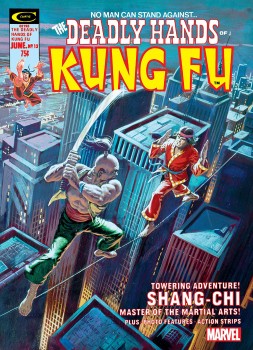 Chapter Two sees Kwai about to eliminate Shareen for possession of the Golden Dragon when Shadow-Thief returns and fights side-by-side with Shang-Chi. Having defeated their opponents, the ninja denies he is Cho-Lee and runs off leaving a bewildered Shang-Chi and Shareen to discover Cho-Lee’s corpse hanging from the rafters. Shareen explains Cho-Lee believed he was Shadow-Thief, a seemingly immortal ninja who she says is believed to be at least two thousand years old. This revelation leaves Shang-Chi questioning reality and pondering the real identity of Shadow-Thief.
Chapter Two sees Kwai about to eliminate Shareen for possession of the Golden Dragon when Shadow-Thief returns and fights side-by-side with Shang-Chi. Having defeated their opponents, the ninja denies he is Cho-Lee and runs off leaving a bewildered Shang-Chi and Shareen to discover Cho-Lee’s corpse hanging from the rafters. Shareen explains Cho-Lee believed he was Shadow-Thief, a seemingly immortal ninja who she says is believed to be at least two thousand years old. This revelation leaves Shang-Chi questioning reality and pondering the real identity of Shadow-Thief.
Shareen waits in her car outside her apartment for safety while Shang-Chi takes her key and goes up to retrieve the real Golden Dragon. As soon as he enters the apartment, he discovers Shadow-Thief has beat him to the statuette. The ninja escapes through a window into a waiting helicopter. Shareen and Shang-Chi track the helicopter by car into Connecticut to a mansion in the woods. Shareen again stays behind for safety while Shang-Chi infiltrates the mansion and dispatches Shadow-Thief’s henchman only to find Shadow-Thief offering him the choice of fighting him for possession of the Golden Dragon or stopping to save Shareen who, inexplicably, is suspended from the ceiling of the next room beneath a descending spiked ceiling while the floor below her is covered with poisonous serpents.
Chapter Three begins with Shang-Chi using a shuriken to dispatch the serpents as rapidly as possible and then managing to free Shareen with literally seconds to spare before the descending spiked ceiling impales them both. While this cliffhanger is exactly the sort one expects from a vintage movie serial (and certainly from one of Sax Rohmer’s novels), there is an unexpected twist. One floor above Shang-Chi and Shareen is Lionel Stern, the owner of the mansion and his mistress, Melissa. The lovers are awakened in the middle of the night completely bewildered by the sound of intruders in their home. Stern, armed with a pistol surprises Shang-Chi and Shareen and plans to call the police when he is interrupted by the sound of a helicopter landing on the roof of the mansion. Shang-Chi quickly disarms Stern and goes after Shad0w-Thief.
Stern’s mistress, Melissa comes downstairs and recognizes Shareen. Following a violent catfight, Melissa is knocked unconscious while Shareen turns the pistol on Stern leaving the reader puzzled as to how the millionaire and his mistress are connected to Shareen in this increasingly complex mystery. Shang-Chi and Shadow-Thief engage in a violent battle on the roof. Shang-Chi is overpowered and Shadow-Thief escapes by helicopter once more. Lionel Stern subsequently informs Shang-Chi that he hired Shadow-Thief to obtain the Golden Dragon statuette for his collection of rare antiquities. He shows them the Golden Dragon Shadow-Thief gave him, but is horrified to learn it is also a worthless imitation. Black Jack Tarr unexpectedly enters the room and announces that Sir Denis Nayland Smith wants the Golden Dragon and he has orders to retrieve it at any cost.
Chapter Four sees Black Jack Tarr interrogate Lionel Stern. The millionaire reveals Shadow-Thief operates out of a curio shop in Manhattan. Shareen attempts to shoot Tarr with Stern’s pistol and then crashes through a window to escape. Tarr and Shang-Chi rush off in his car in an attempt to get to the curio shop before Shareen. Stern places a phone call notifying the curio shop that all is going according to plan. His mistress, Melissa recovers consciousness and, after learning what has transpired, viciously beats Stern until he collapses. The reader is left to puzzle over his mistress’ unexpected proficiency in the martial arts and her possible motivation for turning on her lover.
Shang-Chi and Black Jack Tarr reach the curio shop to discover the backroom is a funeral parlor. The corpse of Cho-Lee, inexplicably sits up in its coffin and speaks, telling them they have reached the Heart of the Dragon. Cho-Lee magically summons six demon ninjas to attack Shang-Chi and reveals Black Jack Tarr is also a disguised demon. Shang-Chi dispatches all seven demon ninjas. When the demon disguised as Tarr is vanquished, his skull splits open to reveal the Golden Dragon statuette. Suddenly, demons and magicians alike vanish and Shang-Chi finds himself alone in the funeral parlor. Leaving the curio shop, he discovers the real Black Jack Tarr has just arrived outside with another MI5 agent, Jenny Quinn. Shang-Chi is startled to recognize Jenny Quinn as Melissa, Lionel Stern’s mistress. Tarr and Quinn explain the Golden Dragon statuette contains a sensitive document stolen from MI5 that Shareen is trying to sell to China, they are dumbstruck by the sight of a massive, living Golden Dragon towering over the streets of Manhattan.
Chapter Five sees the dragon used as a distraction for Shadow-Thief to attempt to assassinate Black Jack Tarr with a poison dart fired from a blowpipe. Shang-Chi saves his friend’s life, but is struck with the poison dart himself. Shadow-Thief then engages the dying Shang-Chi in combat. Just as he is about to vanquish his opponent, both men are swallowed up by the dragon which promptly vanishes into thin air leaving Black Jack Tarr and Jenny Quinn stunned by the bizarre illusion they have witnessed.
Inside the dragon, Shang-Chi plunges into a nightmarish subterranean cave with Shareen, Lionel Stern, and Sir Denis Nayland Smith. The trio vanish and Shang-Chi finds himself back in the funeral parlor, but this time it is Dr. Petrie who sits up from the coffin and tells Shang-Chi that his guilt is a useless emotion that is holding him prisoner. Black Jack Tarr, Jenny Quinn, Kwai, Cho-Lee, and Shadow-Thief then arrive at the funeral parlor. Shadow-Thief attacks Shang-Chi who, weakened and near death, rises to face his doppelganger as the penultimate chapter comes to a bizarre climax.
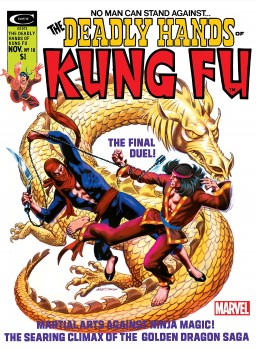 Chapter Six sees Shang-Chi’s vicious fight to the death with his doppelganger. Barely alive, Shang-Chi manages to vanquish his double and staggers toward a life-size statue of the Golden Dragon which again proves to be a worthless imitation. Shang-Chi then wakes from his nightmare and recovers consciousness outside the curio shop. He finds the Golden Dragon statuette lying next to him on the street. Retrieving the statuette, he staggers back inside the curio shop and finds everyone inside as he left them before.
Chapter Six sees Shang-Chi’s vicious fight to the death with his doppelganger. Barely alive, Shang-Chi manages to vanquish his double and staggers toward a life-size statue of the Golden Dragon which again proves to be a worthless imitation. Shang-Chi then wakes from his nightmare and recovers consciousness outside the curio shop. He finds the Golden Dragon statuette lying next to him on the street. Retrieving the statuette, he staggers back inside the curio shop and finds everyone inside as he left them before.
Lionel Stern attacks him when he sees he has the statuette. The Golden Dragon falls to the ground and shatters revealing a ruby inside it. Black Jack Tarr takes the ruby at gunpoint and breaks it open to retrieve the stolen MI5 document. Upon reviewing the paper, he throws it down in disgust. An enraged Stern attacks Shadow-Thief who murders him in cold blood before disappearing into thin air. Cho-Lee reveals Shadow-Thief was his twin and likewise vanishes into thin air. Shang-Chi stops Black Jack Tarr and Jenny Quinn from taking Shareen and Kwai into custody as Chinese agents by pointing out they cannot be held for any crime. The group depart the curio shop feeling cheated that their quest was a fool’s errand. Shang-Chi stops and picks up the crumpled document and reads, “Without a pursuit, life is meaningless and hollow.”
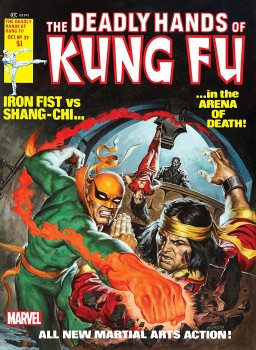 Sadly, the Golden Dragon storyline marked the end of Shang-Chi as a regular feature in the pages of Deadly Hands of Kung Fu. He would not return until Issue #29 for a team-up with Iron Fist whose series had replaced Shang-Chi as the lead feature in the magazine. The story itself was prepared by Doug Moench and Rudy Nebres right after the conclusion of the Golden Dragon storyline, but was left unprinted for a year before it found a place in the schedule.
Sadly, the Golden Dragon storyline marked the end of Shang-Chi as a regular feature in the pages of Deadly Hands of Kung Fu. He would not return until Issue #29 for a team-up with Iron Fist whose series had replaced Shang-Chi as the lead feature in the magazine. The story itself was prepared by Doug Moench and Rudy Nebres right after the conclusion of the Golden Dragon storyline, but was left unprinted for a year before it found a place in the schedule.
The premise itself is solid, though the execution makes less of it than it might have been. The House of Parliament has been wired with explosives. MI5’s demolitions expert, Winston Neville has been abducted by Dr. Fu Manchu. Consequently, Sir Denis Nayland Smith dispenses Shang-Chi to London to confront his father and rescue Winston Neville in time to avert tragedy. Naturally, Fu Manchu anticipates this and Shang-Chi is set upon by a series of ninjas that he overcomes before reaching a gladiatorial arena. Winston Neville is suspended upside down by a cord with a blade to his throat in the center of the arena. The combatants are Shang-Chi and Iron Fist. They learn Fu Manchu is being impersonated by Blevins, a rogue MI5 agent who tells them to fight to the death or he murders Winston Neville. He also offers them the alternative of joining him to defeat Fu Manchu. Naturally, the two gladiatorial combatants team up and defeat Blevins and rescue Neville. However, they are not in time to prevent the detonation of the explosives which, to Sir Denis’ shock, turn out to be harmless. A captive Blevins explains he never intended to destroy the House of Parliament, he just wanted a compelling reason to manipulate Iron Fist and Shang-Chi into supporting his harebrained scheme.
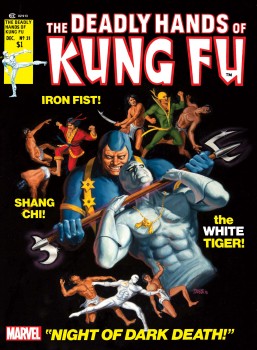
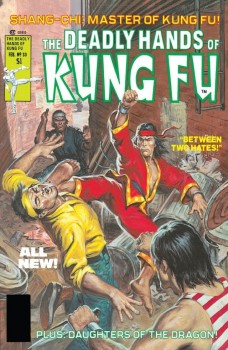 Issue #31 offered another team-up as Shang-Chi and Iron Fist join The White Tiger, The Jack of Hearts, and The Daughters of the Dragon to lay siege to a mob-controlled freighter entering New York Harbor from Chile. There is precious little reason to include Shang-Chi until the revelation that the real power behind the criminal enterprise was to be Dr. Fu Manchu who, in a brief cameo appearance, announces he has carefully considered the mob’s offer to join forces and finds their narcotics operations to be beneath his notice. Fu Manchu having declined the mob’s offer proves the undoing of the traitor who is unmasked in this conclusion of the continuing White Tiger feature in the magazine.
Issue #31 offered another team-up as Shang-Chi and Iron Fist join The White Tiger, The Jack of Hearts, and The Daughters of the Dragon to lay siege to a mob-controlled freighter entering New York Harbor from Chile. There is precious little reason to include Shang-Chi until the revelation that the real power behind the criminal enterprise was to be Dr. Fu Manchu who, in a brief cameo appearance, announces he has carefully considered the mob’s offer to join forces and finds their narcotics operations to be beneath his notice. Fu Manchu having declined the mob’s offer proves the undoing of the traitor who is unmasked in this conclusion of the continuing White Tiger feature in the magazine.
Issue #33 was the final issue of the magazine and offered readers one last Doug Moench-Rudy Nebres Shang-Chi story that was languishing in the archives for over a year. It is, alas, like most of the magazine’s Shang-Chi stories a filler concerned with the dichotomy between the non-violent philosophy at the heart of the martial arts and the way it flourished in the West in the form of overly competitive schools teaching self-defense classes and perpetuating street-fighting in the process. The story also plays with racial stereotypes between whites, blacks, and Asians with even Shang-Chi guilty of making the wrong assumptions for the wrong reasons in concluding that the black man in the ghetto who saved his life is on the wrong side of the law when in fact he is an undercover NYPD detective. The sting at the story’s conclusion is that Shang-Chi’s well-meaning interference actually precipitated tragedy when he inadvertently spoiled a lengthy police investigation into martial arts school rivalries turning violent. The weakness is that over the course of roughly twenty issues, the Shang-Chi feature in Deadly Hands of Kung Fu suffered from repetition and poor comparison with the monthly color Master of Kung Fu title. Only the six-part Golden Dragon storyline offered readers a worthy use of the characters and concepts. As it was, Shang-Chi in the pages of the black & white magazine was a squandered opportunity to give readers a more mature take on the character and his world.
William Patrick Maynard is a writer and film historian. His commentaries have appeared on releases from MGM, Shout Factory, and Kino-Lorber. He is the authorized continuation writer for the Sax Rohmer Literary Estate and is the author of new Fu Manchu thrillers for Black Coat Press.